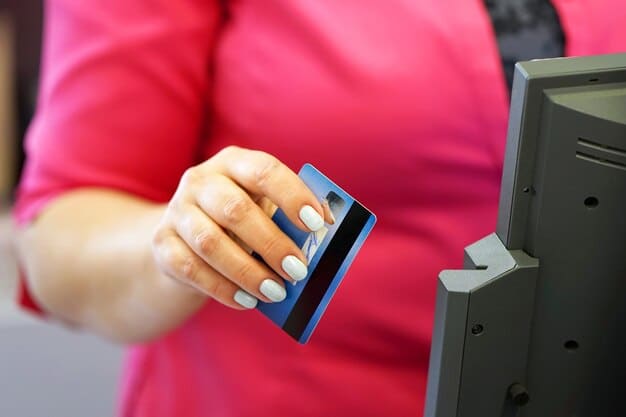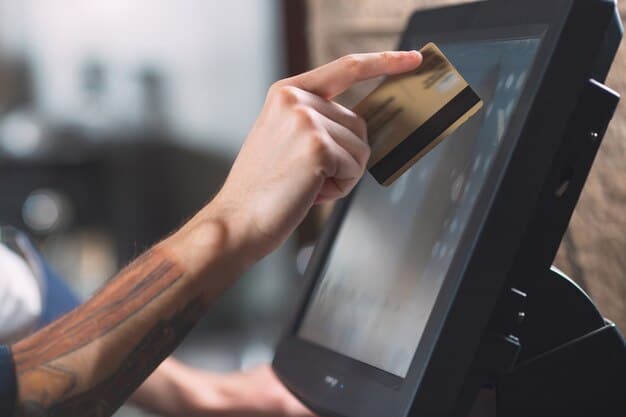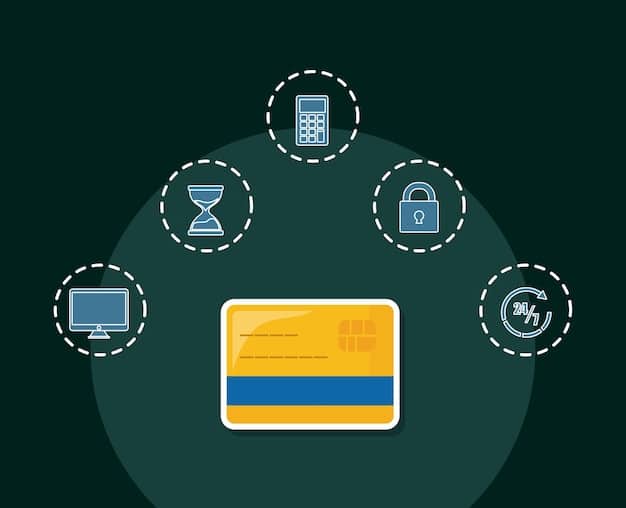Contactless vs. Chip Cards: Which Payment is More Secure in the US?

Contactless payments in the US are generally considered to be as secure as chip cards, if not more so, due to tokenization and dynamic data encryption, which make transactions safer from skimming and counterfeiting.
Are you wondering whether tapping to pay is safer than inserting your chip card at the checkout? The rise of **contactless payments in the US: Are They Really More Secure Than Chip Cards?** has sparked considerable debate about its security compared to traditional chip card transactions.
Understanding Contactless Payment Technology
Contactless payments, also known as tap-to-pay, have become increasingly popular in the US. These transactions use Near Field Communication (NFC) technology, allowing customers to make payments by simply waving or tapping their card or mobile device near a compatible reader.
How NFC Works
NFC is a short-range wireless technology that enables secure data transmission between two devices. When a contactless card or mobile device is tapped near a payment terminal, an encrypted signal is sent to complete the transaction. This process typically takes only a few seconds, making it a convenient option for quick purchases.
Adoption Trends in the US
The adoption of contactless payments has been on the rise in the US, driven by factors such as increased speed and convenience at the point of sale, as well as heightened awareness of hygiene. Many retailers and service providers have upgraded their payment terminals to support contactless transactions, leading to greater usage among consumers.

Contactless payments offer a faster and more convenient alternative to traditional chip card transactions, contributing to their growing popularity among businesses and consumers in the US.
Chip Cards: A Primer
Chip cards, also known as EMV cards, are credit and debit cards that include an embedded microchip. These cards have become a standard security feature in the US, designed to protect against fraud and counterfeiting.
How EMV Technology Works
EMV stands for Europay, Mastercard, and Visa, the three companies that originally developed the technology. When a chip card is inserted into a payment terminal, the microchip generates a unique transaction code, making it more difficult for fraudsters to duplicate or counterfeit the card. This process adds an extra layer of security compared to traditional magnetic stripe cards.
The US Transition to Chip Cards
The United States underwent a significant transition to chip card technology in recent years. This shift was largely driven by the liability shift implemented by payment networks, which placed the financial responsibility for fraudulent transactions on merchants who did not upgrade to EMV-compatible terminals. As a result, many businesses invested in new payment systems to accept chip cards, leading to a decrease in certain types of fraud.
Chip cards have provided enhanced security measures for cardholders and merchants, playing a crucial role in reducing fraud in the US payment landscape.
Security Features of Contactless Payments
Contactless payments incorporate multiple layers of security to protect consumers and merchants from fraud. These features include tokenization, encryption, and dynamic transaction codes. Understanding these mechanisms can help assess the security of contactless payments compared to chip cards.
Tokenization Explained
Tokenization replaces sensitive card data with a unique, randomly generated token. This means that instead of transmitting your actual card number during a transaction, a token is used. If the token is compromised, it cannot be used to access your real card information. Tokenization adds a significant layer of security, especially for online and mobile payments.
Encryption and Dynamic Codes
Contactless payments use encryption to protect the data transmitted between the card or device and the payment terminal. Each transaction generates a dynamic, one-time-use code, preventing fraudsters from capturing and reusing the data for fraudulent purposes. This dynamic code ensures that even if transaction data is intercepted, it cannot be used to make subsequent fraudulent purchases. This is a distinct advantage over static data found on traditional magnetic stripe cards.
Key Benefits:
- Reduced Risk of Cloning: Dynamic codes make it extremely difficult for criminals to clone contactless cards.
- Enhanced Data Protection: Tokenization ensures that actual card numbers are not exposed during transactions.
- Fraud Prevention: Encryption protects data during transmission, reducing the risk of interception.
In summary, the advanced security features of contactless payments, such as tokenization and dynamic codes, offer robust protection against fraud, making them a secure option for both consumers and merchants.

Security Vulnerabilities of Chip Cards
Despite their advanced security features, chip cards are not entirely immune to fraud. Certain vulnerabilities exist that can be exploited by criminals, leading to unauthorized transactions. Understanding these weaknesses is essential for evaluating the overall security of chip cards.
Relay Attacks
Relay attacks, also known as man-in-the-middle attacks, involve an attacker intercepting and relaying transaction data between the card and the payment terminal. This can allow fraudsters to make unauthorized purchases without physically possessing the card. While EMV chip cards are designed to prevent skimming and counterfeiting, they are still susceptible to relay attacks in certain scenarios, particularly if the transaction process is not fully secured.
Counterfeit Cards
Although chip cards are more difficult to counterfeit than traditional magnetic stripe cards, sophisticated criminals can still create fake chip cards using compromised or stolen card data. These counterfeit cards can then be used to make fraudulent purchases at merchants who accept chip card payments. The presence of counterfeit chip cards highlights the ongoing need for advanced security measures to protect against fraud.
Despite the enhanced security features of chip cards, vulnerabilities such as relay attacks and counterfeiting can still pose a threat to cardholders and merchants. While chip cards have greatly reduced fraud, they have not eliminated it entirely, emphasizing the need for continuous improvements in payment security.
Comparing Security: Contactless vs. Chip
When evaluating the security of contactless payments versus chip cards, several factors must be considered. Both payment methods have their strengths and weaknesses, and the choice between them often depends on specific circumstances and priorities.
Transaction Speed and Convenience
Contactless payments generally offer a faster and more convenient transaction experience compared to chip cards. Tapping to pay is quicker than inserting and waiting for a chip card to process, making it a popular choice for consumers who value efficiency. However, this speed can sometimes come at the expense of security, as faster transactions may be more vulnerable to certain types of fraud. Faster transactions can lead to quicker unauthorized access if a breach occurs, emphasizing the constant balancing act between convenience and security.
Risk of Skimming and Data Theft
Chip cards have significantly reduced the risk of skimming and data theft compared to magnetic stripe cards. However, as mentioned earlier, they are still susceptible to relay attacks and counterfeiting. Contactless payments, on the other hand, incorporate tokenization and dynamic transaction codes, which provide an additional layer of protection against these types of fraud. While neither payment method is completely immune to security breaches, contactless payments generally offer better protection against skimming and data theft.
Liability and Consumer Protection
In the US, both contactless payments and chip cards are subject to consumer protection laws and regulations that limit liability for unauthorized transactions. If a consumer’s card is used fraudulently, they are typically not responsible for the full amount of the charges, provided they report the fraud promptly. The specific liability rules may vary depending on the card issuer and the circumstances of the fraud but generally offer strong protections for consumers.
In conclusion, the choice between contactless payments and chip cards often depends on individual preferences and security priorities. Both payment methods offer a reasonable level of security, but contactless payments have the edge in terms of technology and consumer protection.
Best Practices for Secure Transactions
Regardless of whether you prefer contactless payments or chip cards, there are several best practices you can follow to ensure secure transactions. These steps can help you protect your financial information and reduce your risk of fraud.
Protecting Your Card and Device
One of the most important steps you can take is to protect your card and device from loss or theft. Keep your card in a secure place, and consider using a wallet or cardholder with RFID-blocking technology to prevent unauthorized scanning. For mobile devices, use a strong passcode or biometric authentication to protect your device from unauthorized access.
Monitoring Your Accounts Regularly
Regularly monitoring your bank and credit card accounts can help you detect and report fraudulent transactions promptly. Review your statements carefully, and set up alerts to notify you of any unusual activity. If you notice any unauthorized charges, report them to your bank or card issuer immediately. This vigilance helps ensure that you are aware of any potential security breaches and can take swift action to minimize the damage.
Being Aware of Phishing and Scams
Phishing and scams are common tactics used by criminals to steal sensitive information. Be wary of suspicious emails, phone calls, or text messages asking for your personal or financial information. Never click on links or download attachments from unknown sources, and always verify the authenticity of any communication before responding. Staying alert and informed about common scams can help you avoid falling victim to fraud.
By following these best practices, you can enhance the security of your transactions and reduce your risk of fraud, regardless of whether you choose contactless payments or chip cards. Taking proactive steps to protect your financial information can provide peace of mind and help you stay one step ahead of criminals.
| Key Point | Brief Description |
|---|---|
| 🛡️ Tokenization | Replaces card data with a unique token, enhancing security. |
| 🔒 Encryption | Protects data during transactions with dynamic codes. |
| ⏱️ Transaction Speed | Contactless payments are generally faster than chip cards. |
| 🚨 Monitor Accounts | Regularly check for unauthorized transactions to prevent fraud. |
[Título da seção FAQ em en-US]
▼
Yes, contactless payments are generally safe due to tokenization and encryption, which protect your card information during transactions. These features significantly reduce the risk of fraud.
▼
It is difficult for someone to steal your information through contactless payment because each transaction generates a unique code, making it hard for fraudsters to reuse the data.
▼
Yes, chip cards are significantly safer than magnetic stripe cards because they generate a unique transaction code for each purchase, reducing the risk of skimming and counterfeiting.
▼
To protect yourself, regularly monitor your accounts for unauthorized transactions, keep your card and devices secure, and be cautious of phishing scams asking for your payment information.
▼
If you suspect fraud, immediately report it to your bank or card issuer. They will investigate the issue and take steps to protect your account and limit your liability.
Conclusion
In conclusion, both contactless payments and chip cards offer robust security features for transactions in the US. Contactless payments leverage advanced technologies like tokenization and encryption, providing a secure and convenient payment method. By staying informed and following best practices, consumers can confidently use either payment option, knowing they are well-protected against fraud.





